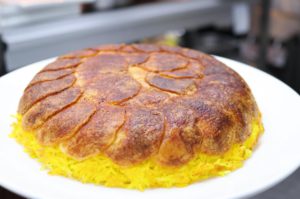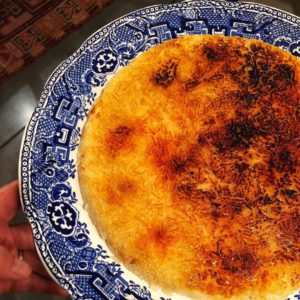As a full-blooded Ashkenazi (“only-child” to boot!), marrying into a very large (my husband has 8 sibings) Sephardic family, one of the first lessons I learned as a young bride was that a good part of my suitability for the new role was hinged on the quality of my rice ¬–most specifically, the bottom of the rice, fondly known as the tahdig (pronounced exactly as it is spelled). Having come from a home that served perhaps a scant half-cup of Minute Rice, or the like, a few times a year (we were more of the kugel persuasion), even knowing how to come up with good rice, fragrant rice, rice that did not stick together and was delicious, was a challenge.
Then I discovered that the bottom of that beloved rice was the “acid test” of my new culinary skills. Well, it took some practicing. It took some burnt products –some overcooked pots of rice that resembled porridge with a burnt taste and blackened bottoms; it took some undercooked attempts, with rice that was still hard (be assured, hard, under-cooked rice does NOT equal in any way the much coveted tahdig, despite the latter’s crunch and hard outer surface!), often over-salted, sometimes, tasting like wallpaper glue, and under-salted, until perfection came my way. It is truly an art, and with all arts, practice makes perfect.
This recipe is all about the technique! I cannot say that emphatically enough! The ingredients are very simple. The idea is that you don’t mix in anything with the rice until just before serving (veggies, etc…) and even more important that you don’t let the steam ruin the much sought-after tahdig- crunchy bottom of the rice. All Persian cooks are judged by the quality of their tahdig! This is your goal- fluffy rice that separates, that you can easily lift in your fingers that cascades grain by grain separately, and a thick crunchy golden tahdig!
Think about how much cooked rice you want to end up with. Generally, ¾ cup cooked rice per person is more than enough, unless your crowd is Persian, in which case you may want to allot 2 cups of rice each (that is no exaggeration, trust me!)
INGREDIENTS:
Basmati rice, white or brown
water
oil (corn is great for this)
salt
**vegetables to toss in (more on this later)
saffron (optional)
A few important notes:
*Start with a good non-stick pan- this is super important!
*Use ONLY Basmati rice (DO NOT USE UNCLE BEN’S, MINUTE RICE, OR ANY OTHER INSTANT OR “AMERICAN” rice!! You will wind up with a pot of paste!). Besides being fabulously fragrant, like popcorn, Basmati is the gold standard of Eastern rice. It is very tough and will stand up to the double cooking that you will be doing. You can use white or brown Basmati, but keep in mind that brown rice will need extra rinsing and time cooking. This recipe is written for white Basmati rice.
(These measurements are for about 5 cups of finished rice. You will get more familiar with portions and proportions as you practice cooking rice.)
DIRECTIONS:
1.Take about 6 cups of water and about a tablespoon of salt and bring to a rolling boil in a medium size non-stick pot. If you would like yellow rice and/or the flavor of saffron, place a few threads of saffron in the water. If you would like a less expensive, though different flavor, you can use turmeric, but be careful- the water will boil more quickly and will boil over with turmeric added (like happens with boiling milk).
2. Add 2 cups of Basmati rice to the boiling water and allow water to come back to a full boil. This whole time should be about 8-9 minutes.
3. After the rice has parboiled, pour the hot water and rice through a colander, and rinse the rice with cold water to thoroughly wash off the starch.
4. Pour about 3/4 cup water and 1/2 cup oil (corn oil works especially well here- no olive oil- way too delicate and is unhealthy when heated too high) back in the pot and spoon the rice back in the pot, creating a mound (like a little “volcano” of rice… using the back of a long handle spoon, create a well down the center of the mound. (YOU CAN ADD MORE SAFFRON TO THE OIL THAT YOU PUT IN THE POT AT THIS POINT; IT WILL BE VERY FRAGRANT AND FLAVOR THE RICE STRONGLY IF YOU USE IT HERE).

Making the well for the center steam to escape- like a little volcano!
*ESPECIALLY GREAT OPTION!!: when you place the rice back into the pot for the second stage of cooking, you can add sliced potato in a flower pattern around the circumference of the pot, and into the middle, if you want a fully potato tahdig. The potatoes should be sliced about ½ inch thick, and left unpeeled. You must be especially careful about cooking your rice when you use potatoes in your tahdig- don’t let them burn!

Potato tahdig- be extra careful not to burn
5. Place a paper towel or light dishcloth loosely over the rice mound, and then tuck it into the pot so it won’t stick out from under the lid and go on fire. If you are using a dishtowel, you can even tie it up over the handle of your pot. Cover your pot with a lid that allows the steam to escape (cover should have a little hole in it- typically a glass lid).
6. Place the rice on a low-medium fire for about an hour; the more time you have, the better the tahdig you will have at the end… the lower the fire and longer the cooking time, the better the tahdig will be. DURING THIS COOKING TIME YOU CAN POUR A LITTLE MORE OIL DOWN THE CENTER OF THE RICE NOW AND THEN. HERE IS YOUR CHANCE TO ADD SOME SAFFRON THREADS AGAIN (can you tell that Persians LOVE saffron?) TO YOUR OIL. IT IS VERY GOOD TO ADD HERE IF YOU LIKE THAT FLAVOR.
7. As your rice is cooking, you may want to poke down to the bottom with a spoon handle to “listen” for the sound of a crunchy hard bottom. The rice should smell increasingly like cooking popcorn. Keep that flame low, or you will burn the bottom, and especially with that oil you added it will turn black and make your pot of rice taste burnt.
8. You will get a sense of when the rice is done as you become more familiar with this cooking technique. Your rice on the top should be fluffy, and the bottom a thick golden crunchy solid. If you have really aced this, your tahdig should be about ¾ inch thick! When it is ready, take out a large round (or oval if you are cooking for lots of people) serving dish, and turn your pot upside down over the plate, allowing the cooked rice to fall onto the plate gently. The tahdig will be a round solid atop your fluffy rice. You can leave it there, or place it on a separate plate.
